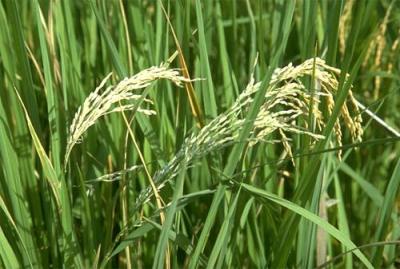

Blast (Pyricularia oryzae (Magnaporthe grisea)
This disease can cause serious losses to susceptible varieties during periods of blast favourable weather. Depending on the part of the plant affected, the disease is often called leaf blast, rotten neck, or panicle blast. The fungus produces spots or lesions on leaves, nodes, panicles, and collar of the flag leaves. Leaf lesions range from somewhat diamond-shaped to elongated with tapered, pointed ends. The centre of the spot is usually grey and the margin brown or reddish-brown. Both the shape and colour of the spots may vary and resemble those of the brown leaf spot disease. Blast differs from brown leaf spot in that it causes longer lesions and develops more rapidly.
The blast fungus frequently attacks nodes at the base of the panicle and the branches of the panicle. If the panicle is attacked early in its development, the grain on the lower portion of the panicle may be blank giving the head a bleached whitish colour, giving the name "blasted" head or rice "blast". If the node at the base of the panicle is infected, the panicle breaks causing the "rotten neck" condition. In addition, the fungus may also attack the nodes or joints of the stem. When a node is infected, the sheath tissue rots and the part of the stem above the point of infection often is killed. In some cases, the node is weakened to the extent that the stem will break causing extensive lodging. Blast generally occurs scattered throughout a field rather than in a localised area of the field. Late planting, frequent showers, overcast skies, and warm weather favour development of blast. Spores of the fungus are produced in great abundance on blast lesions and can become airborne, disseminating the fungus a considerable distance. High nitrogen fertilisation should be avoided in areas that have a history of blast.
- Plant early.
- Avoid excessive or high levels of nitrogen.
- Proper flood (water) management.
- Plant resistant varieties (e.g. "NERICA". This is the most effective method of controlling rice blast.
